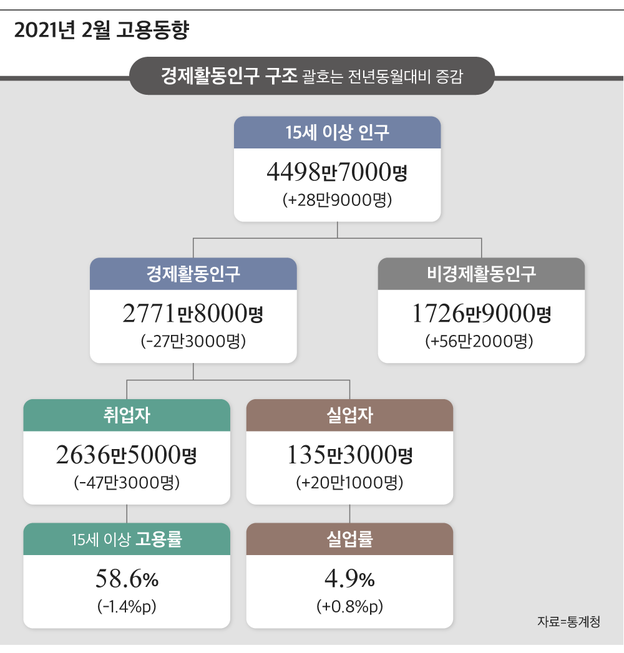Enter 2021.03.17 08:00
Employment rate of 15-64 years old was 64.2%, the lowest in 6 years
Until last February, the number of employed has declined for 12 consecutive months. This is the longest consecutive decline since the decline for 16 months from January 1998 to April 1999, when the International Monetary Fund (IMF) started the financial crisis.
The number of unemployed was 1353,000, a record high as of February. It was the highest since 2017, recording 1.342,000 people. The unemployment rate was also 4.9%, a record high as of February.
On the 17th, the National Statistical Office announced the’February Employment Trend’. The number of employed was 26365,000, a decrease of 473,000 compared to the same month last year. The decline was somewhat reduced compared to the previous month (982,000), when the number of employed people decreased the most since the IMF. The employment rate between the ages of 15 and 64 was 64.2%, the lowest level in six years since February 2014.

“The decline in the number of employed people compared to the previous month was due to a downward adjustment on the 15th, when the social distancing stage was during the employment trend survey period (February 14-20),” said Chung Dong-myeong, director of the Social Statistics Bureau of Statistics Korea. “The government’s public jobs The start of the business also had an impact,” he explained.
The number of unemployed people was 1353,000, an increase of 201,000 compared to the same month last year. This is an all-time high as of February. The’unemployed’ counted by the National Statistical Office is a person who did not work with income during the week of the survey, and actively sought a job for the past four weeks. It refers to a person who can be employed immediately when a job is given.
As the government’s public jobs project resumed, the number of people aged 60 and over increased by 212,000. In January, when the public job business was stopped due to the novel coronavirus (Corona 19), the number of employed people aged 60 and over declined, but when the business was restarted, the number of elderly employed also increased. On the other hand, there were 238,000 people in their 30s, 166,000 people in their 40s, 139,000 people in their 50s, and 106,000 people in their 20s.
The effect of resumption of public jobs is also seen in the increase and decrease of the number of employed by industry. The number of employees employed in the health and social welfare services industry, which is an industry with a large distribution of public job projects, increased by 91,000 (4.0%) compared to the same month last year. In January, when there was no job business, the number of employed in this industry decreased by 74,000, and then increased again in February. In addition, the number of employed persons in public administration, national defense and social security administration (38,000 persons·3.7%) and agriculture, forestry and fisheries (33,000 persons·2.7%) increased.
On the other hand, during this period, the number of employed decreased in industries that were directly affected by social distancing for COVID-19 quarantine. Accommodation and restaurant business (-232,000 people·-10.2%), wholesale and retail business (-194,000 people·-5.4%), associations and organizations, repair and other personal service businesses (-84,000 people·-6.8%) The back was hit.
Looking at the number of employed by job position, the number of regular workers, which means relatively stable jobs among wage workers, increased by 82,000 (0.6%). Meanwhile, the number of temporary workers decreased by 317,000 (-7.0%) and the number of daily workers decreased by 80,000 (-6.2%). The proportion of full-time workers among the total employed was 55.7%, an increase of 1.3 percentage points (points) from the same month last year.
During this period, the inactive population was 17269,000, an increase of 562,000 compared to the same month of the previous year. The inactive population is a person who is neither employed nor unemployed among the population aged 15 or older. These are people who do not engage in economic activities or are taking a break without intention to do economic activities, such as full-time housewives, senior citizens, job seekers, school preparers, and job seekers.
Looking at the inactive population by sector, the number of households (331,000 people, 5.6%) and rest (216,000 people, 9.2%) increased compared to the same month last year. Among the inactive population, the number of those who gave up job hunting was 752,000, an increase of 218,000 from the same month last year. Job seekers are those who wished to find a job among the inactive population and were able to find a job, but among those who did not find a job due to labor market reasons, they had experience in finding a job within the past year. The number of people preparing for employment increased by 83,000 (10.8%) to 853,000.
On this day, Hong Nam-ki, Deputy Prime Minister of the Economy and Minister of Strategy and Finance, gave a’self-praise’ on his Facebook page for the decline in the number of employed people in February. He said, “The difficulties in the employment market due to the third spread of Corona 19 have been remarkably mitigated.” In Edo, the improvement in the employment index is expected to continue,” he wrote.
